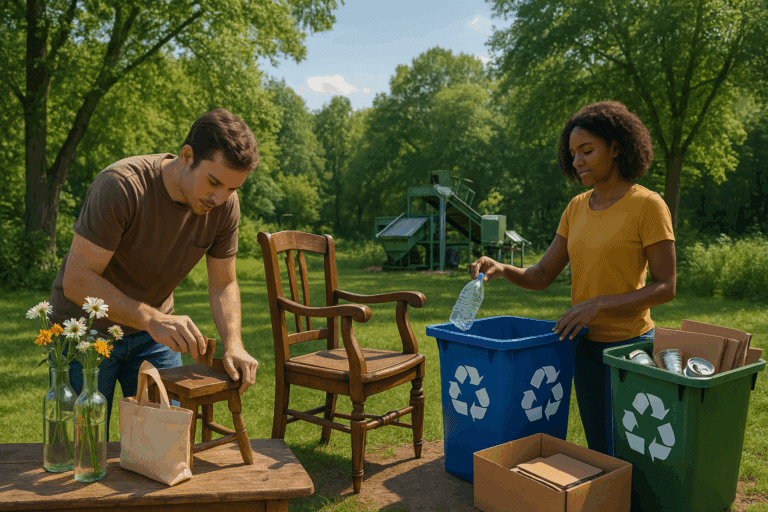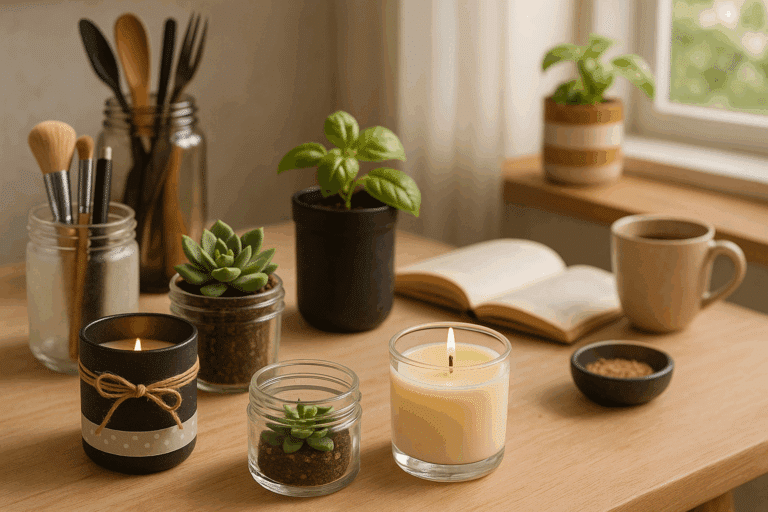Is the same old setup lacking the charm it once had? Maybe it’s time to introduce a new wave of creativity into your garden. The answer to your woes might just be sitting in your kitchen cabinet. We’re talking about transforming your outdoor spaces using upcycled dishware – broken plates, mugs, cups, and bowls. 🍽️💡
Yes, you heard it right! Those chipped and shattered pieces that you were just about to throw away can become the essence of a stunning garden makeover. So before you rush to sweep away those ‘good for nothing’ fragments, consider this: those pieces could add unique, personal touches to your garden that you can’t buy in any store. If you’re intrigued by the idea, this blog post is the perfect guide for you. 📖
Broken Dishes: From Trash to Treasure 🏺
In this age of fast fashion and disposable goods, we often forget the value of reusing and recycling. The practice of upcycling, or creatively repurposing waste materials, has gained momentum in recent years as a sustainable, cost-effective alternative to buying new products. The process not only extends the life of materials but also adds a distinct, personal flair to them. It’s about finding the inherent beauty in things often considered as junk.
With a little creativity, broken dishware can be transformed into stunning mosaics, flower pots, bird feeders, or decorative elements that could dramatically enhance the aesthetics of your garden. By the end of this article, you will have a plethora of ideas to start your own upcycling project, turning your garden into a personal haven filled with memories and unique charm. 🌸🌱
Exploring the Potential of Upcycling 🌟
While the thought of upcycling might initially seem daunting, the practical aspect is far from it. It’s a rewarding process that nurtures your creativity, promotes sustainability, and results in personalized décor items that can’t be replicated. So, whether you’re an experienced DIYer or a newbie dipping your toes into the world of upcycling, this guide will provide you with the knowledge and inspiration needed to transform your garden using broken dishes.
We’ll delve into the various ways you can use broken dishware in your garden, the tools you’ll need, and step-by-step instructions for creating stunning outdoor décor. Additionally, we’ll explore how you can ensure the safety of your new garden decorations, considering the sharp edges of broken dishware. ☝️🔨
What to Expect in this Guide 📘
From designing eye-catching mosaics that would make any wall or pathway sparkle to creating adorable, miniature fairy gardens in broken pots, this guide will take you through numerous creative avenues. We’ll discuss the different types of dishware suitable for each project, how to prepare and handle the pieces, and finally, how to assemble and display your creations.
What’s more, we’ll even touch upon maintaining and preserving your pieces against weather conditions, so they continue to enhance your garden for years to come. Be prepared to roll up your sleeves, let your creative juices flow, and turn your garden into a unique masterpiece with broken dishes! 🎨💪
So, are you ready to breathe new life into your garden with a dash of creativity and a pinch of sustainable living? Prepare to see your outdoor space in a new light, as we embark on this exciting journey of transforming your garden with upcycled dishware. Let’s dive in! 🏊♂️
Unleash Your Creativity: Transform Your Garden with Upcycled Dishware
There is an inspiring movement taking root in the world of gardening and outdoor decor. It’s the art of using upcycled dishware to create stunning outdoor displays. This creative and eco-friendly approach not only gives a second life to broken or unused dishes but also adds a unique and personal touch to your garden decor.
Whether it’s turning shattered plates into mosaic stepping stones or turning old tea cups into bird feeders, the possibilities are as vast as your imagination. But before we dive into the creative ways you can use broken dishes, let’s first discuss the concept of upcycling and why it’s beneficial for our environment.
Upcycling is the process of converting waste materials or useless products into new materials or products of better quality or environmental value. It’s a great way to reduce waste and the demand for new resources, promoting a more sustainable lifestyle. Upcycling dishware for your garden is a prime example of this.
The Whys and Hows of Upcycling Broken Dishware
Before we get into the creative techniques and ideas for upcycling dishware, it’s essential to understand why and how to do it. Many of us might have broken dishes at home that we no longer use. Instead of throwing them away, these can be repurposed into beautiful pieces of outdoor decor.
When it comes to upcycling, safety is a priority. Always remember to handle broken dishes with care to avoid any injuries. Wear gloves and safety glasses, especially when breaking or cutting dishes. Also, remember to prepare a safe working space where you can easily clean up afterward.
As for how to break your dishes, you can use a hammer or tile nipper, depending on the size and shape you want for your pieces. Wrapping the dish in an old towel before breaking it can help contain the shards. Make sure to keep your broken pieces organized by color, size, or shape for easier designing later on.
Creative Ways to Use Broken Dishes in Your Garden
Now that we’ve covered the basics of upcycling and safety precautions, let’s dive into the fun part: the creative ideas. Here are some unique ways you can use broken dishes to spruce up your garden.
1. Mosaic Stepping Stones
One of the most common ways to use broken dishes is to create mosaic stepping stones. This idea is not only aesthetically pleasing but also practical. You can create a pathway in your garden or use them as decorative accents. To do this, you will need a stepping stone mold, concrete mix, and your broken dish pieces.
2. Dish Flowers
For a touch of whimsy, why not create some dish flowers? To do this, you can layer different-sized dishes or lids on top of each other, securing them with waterproof adhesive. You can then attach them to a rod or stick to “plant” them in your garden.
3. Tea Cup Bird Feeders
If you have broken tea cups or mugs, don’t throw them away. Instead, turn them into adorable bird feeders. Simply glue the cup to the saucer, add a string or chain, fill it with birdseed, and hang it from a tree.
Video Tutorial: DIY Mosaic Stepping Stone
To give you a clearer idea of how to create your own mosaic stepping stone, here’s a handy video tutorial from the YouTube channel ‘DIY Mom’: “DIY Mosaic Stepping Stone – Easy and Fun!”
Watch the video below to get a step-by-step guide on making your own mosaic stepping stone:
Final Thoughts
Upcycling broken dishes for your garden is not only a creative and fun project but also a meaningful one. It’s a small step towards sustainability that can make a big difference. Not only are you giving new life to something that was once considered waste, but you’re also creating a unique and personal piece of decor for your garden.
So the next time you break a dish, don’t see it as a loss. See it as an opportunity for a new creative project for your garden. Happy upcycling!
Join the Upcycling Movement
Now that you’re armed with all this knowledge, are you ready to join the upcycling movement? Start with that pile of broken dishes you’ve been meaning to throw away. Instead of contributing to the landfill, turn them into stunning pieces of outdoor decor. Remember, creativity has no bounds. So go ahead, and transform your garden with upcycled dishware!
You can also share your projects and ideas with other upcyclers online. Social media platforms like Pinterest, Instagram, and Facebook have plenty of groups dedicated to upcycling where you can find inspiration and share your creations. Start today and make a difference one dish at a time!

Conclusion
After thoroughly exploring and explaining the intricacies of the topic at hand, we now arrive at the end of our article. The journey was challenging, stimulating and thought-provoking, but most importantly, it has been educational. It is vital to remember that in the world of information technology and engineering, continuous learning and application are the essential keys to staying relevant and competitive.
Throughout the article, we examined the complexities of the topic, breaking down each segment into comprehensible chunks. We navigated through the theoretical frameworks, explored the practical applications, and dived into the benefits and challenges of the subject matter. We also shone a spotlight on real-world examples, giving the reader a clear image of how these concepts play out in the professional field.
One of the most significant aspects we addressed is the importance of having a deep and broad understanding of the topic. Given the highly technical and complex nature of the subject, it is crucial for professionals and enthusiasts alike to grasp the concepts thoroughly. Whether it’s a deep dive into code or a high-level overview of a system architecture, understanding the ins and outs is the first step towards mastery.
Just as importantly, we also emphasized the importance of continuously learning and staying updated. The world of technology and engineering is a dynamic, ever-evolving landscape that requires constant attention and dedication. That’s why we encourage you, dear reader, to take what you’ve learned here and apply it in your own projects and pursuits. It’s not enough to merely read and understand; the real growth comes from practical application and hands-on experience.
The information and insights presented in this article were carefully selected and compiled from reliable sources, aiming to provide you with the most relevant and up-to-date knowledge. For further reading and research, you may refer to these resources:
Source 1
Source 2
Source 3
We also want to hear from you. Your feedback, insights, and experiences enrich the conversation and contribute to the collective knowledge of our community. So don’t hesitate to leave your comments, share this article, and start a conversation with your peers and colleagues! 📚🚀💡
In conclusion, remember that the journey to mastery is not a sprint, but a marathon. The more you learn, the more you realize there’s so much more to know. So keep learning, keep growing, and most importantly, keep exploring. As the famous saying goes, the journey of a thousand miles begins with a single step. Let’s take that step together, and see where this exciting journey takes us. 🚀🌟
Thank you for reading and engaging with us. We hope you found this article informative and inspiring. Happy learning!
Source Reference:
Source Reference 1
Source Reference 2
Source Reference 3



